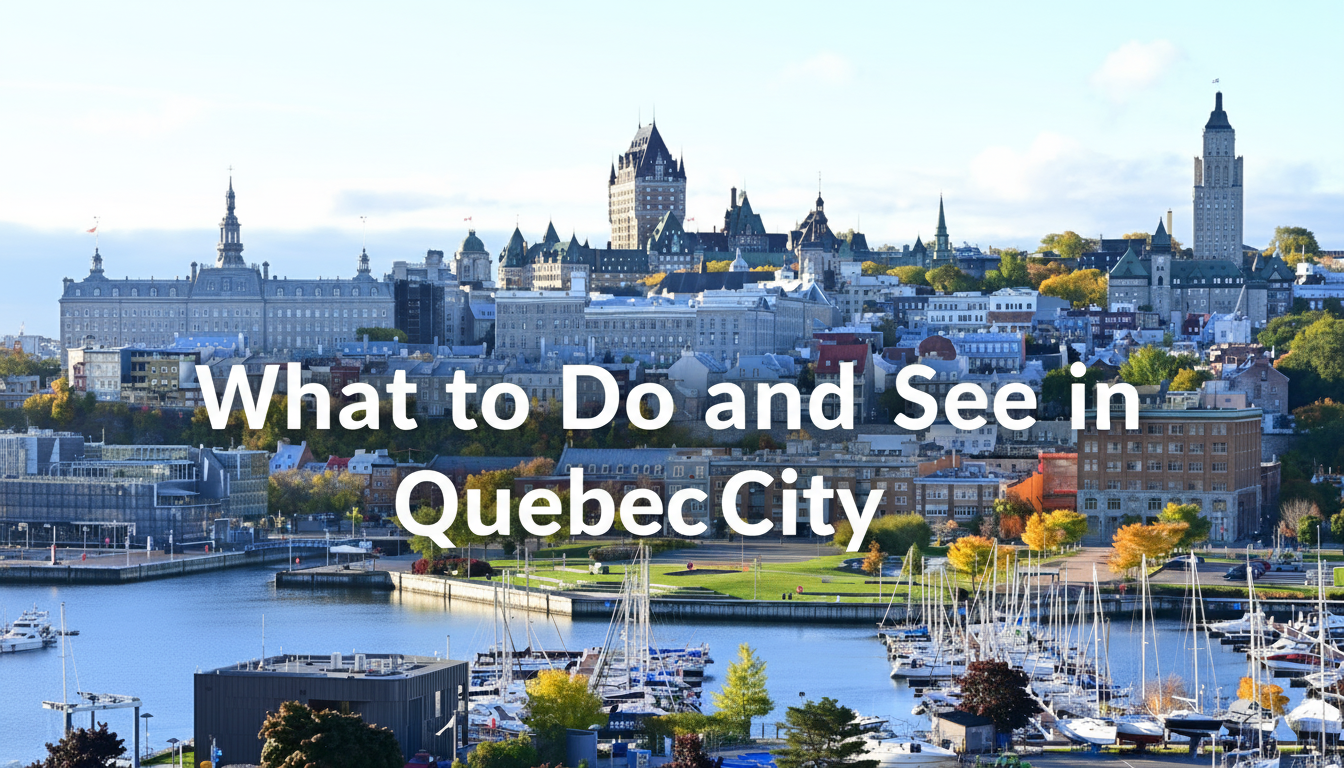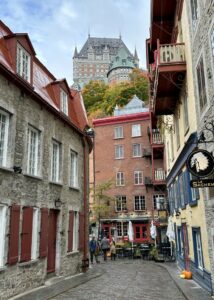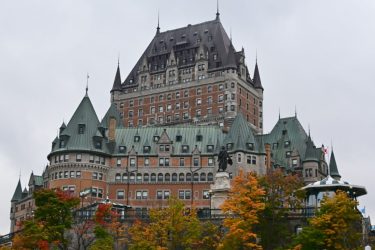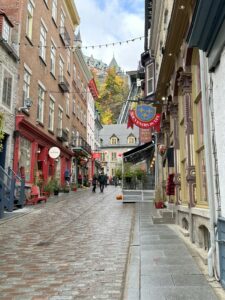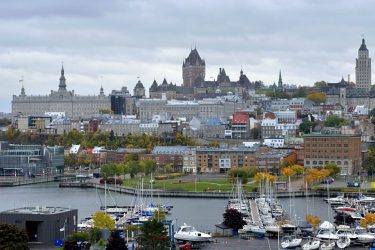Quebec City is a must-visit location in Canada because it offers an enthralling fusion of culture, history, and scenic beauty. Rich in French colonial history, Quebec City is well known for its beautifully maintained Old Town, which is recognized as a UNESCO World Heritage site, and for its unique fusion of European elegance and North American energy.
Explore Old Quebec’s Upper Town (Haute-Ville) and Lower Town (Basse-Ville), each of which has its own special charms, to start your journey. Famous sites like the imposing Château Frontenac, the storied Place Royale, and the magnificent Notre-Dame de Québec Basilica-Cathedral can be found in Upper Town, which is positioned atop Cap Diamant. During a stroll down its cobblestone streets, tourists come across attractive cafes, art galleries, and little stores.
Lower Town, located beside the St. Lawrence River, beckons exploration with its charming stores, winding lanes, and lively food scene. Discover the charming Quartier Petit Champlain, which is well-known for its handcrafted goods and energetic vibe, or stroll idly along the Dufferin Terrace for expansive views of the city and the river.
Beyond its historic center, Quebec City provides diverse cultural activities like touring the ancient battlefield of the Plains of Abraham, visiting the Musée national des beaux-arts du Québec, or admiring the magnificence of the Citadel, an operational military fortress. The city also organizes exciting annual festivals that feature food, art, and music, such as the Summer Festival and the Quebec Winter Carnival.
Visit Quebec City for an amazing voyage through history and culture, where every corner exposes a new tale and a unique experience, thanks to its blend of old-world charm, scenic beauty, and a thriving cultural scene.
This article, we will give you what are the best things to do and see when you visit this beautiful and historic city of Quebec City.
Visit Old Quebec
Discovering Old Quebec is akin to entering a time capsule from Europe right here in North America; it offers an enthralling fusion of culture, history, and architectural beauty. One of the best-preserved fortified cities in the Americas, this quaint area is recognized as a UNESCO World Heritage site. It features attractive squares, small cobblestone alleyways, and buildings from the 17th and 18th centuries.
Divided into two main sections, Upper Town (Haute-Ville) and Lower Town (Basse-Ville), the center of Old Quebec is connected by twisting streets, funiculars, and steep staircases. Famous sites like the Château Frontenac, a historic Fairmont hotel whose turrets and grandeur dominate the skyline, may be found in Upper Town. Explore the attractive Place Royale, the oldest public plaza in North America, which is close by and is flanked by the Notre-Dame-des-Victoires Church, as well as quaint shops and cafes.
Lower Town, with its charming lanes, artisan stores, and historic landmarks like the Old Port, is tucked away along the St. Lawrence River and offers a more personal ambiance. Wander through the Petit-Champlain neighborhood, which is well-known for its handcrafted goods and holiday décor, or visit the Museum of Civilization to learn more about the rich cultural history of Quebec.
Numerous cultural activities are available to visitors in Old Quebec, such as guided tours, historical re-enactments, and museum visits to places like the Morrin Center and the Ursulines Museum. The lively eating scene in the neighborhood features everything from luxury restaurants with expansive views of the city and river to little bistros serving classic Quebecois cuisine.
All things considered, Old Quebec is a historical and charming treasure trove, beckoning tourists to explore its fascinating streets and buildings and become fully immersed in its distinct fusion of French and North American culture.
See the Chateau Frontenac in Quebec City
One of Quebec City’s most famous sights is the Château Frontenac, which perfectly captures the allure, legacy, and architectural magnificence of the city. This ancient hotel, a symbol of Quebec City, is perched majestically on a bluff overlooking the St. Lawrence River. It is widely considered to be one of the most photographed hotels in the world.
American architect Bruce Price created the Château Frontenac, which was first erected in 1893 by the Canadian Pacific Railway, in the recognizable French château style. Its towers, steep copper roofs, and commanding front transport one back to a more elegant and romantic time in history. The hotel’s appeal is increased by its setting within Old Quebec, a UNESCO World Heritage site, which is encircled by picturesque buildings, cobblestone streets, and expansive views.
Though the Château Frontenac is visible from many locations in Quebec City, entering the building exposes even more of its historic splendor. Grand staircases, sophisticated lounges, and exquisite artwork adorn the hotel’s foyer and public areas, which provide a window into its luxurious past.
The Château Frontenac also provides a variety of eating options, from informal to elegant, so guests may savor their meals while taking in breath-taking views of the Old City or the river. The terrace of the hotel and the adjacent Dufferin Terrace are great places to appreciate the outside of the Château and to enjoy the breath-taking views of the river and the Lower Town below.
The Château Frontenac, which is a must-see location that encapsulates the historic charm and architectural magnificence of Quebec City, is a memorable aspect of any trip to this enchanted city, whether it is seen from a distance or experienced up close.
Visit the Citadel in Quebec City
A trip through architectural magnificence and military history, a visit to the Citadel in Quebec City provides an insight into Canada’s defines tactics, both past and present. As the oldest military structure in Canada, the Citadel is a famous landmark of Quebec City, perched atop Cap Diamant with a commanding view of the St. Lawrence River.
Built between 1820 and 1850, the Citadel is a striking example of a military fortress with bastions meant to fend off attacks and ramparts shaped like stars. Currently functioning as the headquarters for the Royal 22nd Regiment, also referred to as the Van Doos, it is still an operational military station. Visitors can learn about the Citadel’s strategic significance and the troops’ daily routines by taking guided tours of the fortress.
The daily Changing of the Guard event, which happens from June to September, is one of the attractions of a visit to the Citadel. The guards, who are dressed in their characteristic scarlet uniforms, provide an insight into military discipline and customs by performing a ceremonial march to music.
The museum, housed inside the Citadel, features artefacts, clothing, weapons, and interactive displays that describe the history of the stronghold and its significance in Canadian military history. From the ramparts of the Citadel, one may enjoy breath-taking views over Quebec City, the river, and the surrounding countryside.
With its unique blend of teaching and exploration, the Citadel appeals to history buffs and everyone with an interest in military architecture.
Explore the Plains of Abraham in Quebec City
Discovering Battlefield Park, sometimes referred to as the Plains of Abraham, is an excursion through one of Canada’s most important historical sites. This large urban park, which lies in the center of Quebec City, is not only a historically significant site in North America but also a beautiful natural setting. During the Seven Years’ War, the legendary Battle of the Plains of Abraham took place between British and French forces. The outcome of the battle left a lasting impact on the colonial landscape of the continent.
Presently, the Plains of Abraham comprise an expansive green area of over 240 acres, providing a combination of historical sites, picturesque scenery, and leisure amenities. Starting points for exploration include the interactive exhibits, relics, and multimedia presentations of the Plains of Abraham Museum, which offers a compelling summary of the war and its aftermath.
Statues and memorials honoring the generals on both sides of the conflict can be seen all across the park, including the Wolfe-Montcalm Monument. Visitors can take in expansive views of the surrounding cityscape and the St. Lawrence River while strolling or riding along any of the many routes. The park offers a serene environment for outdoor activities like picnics and leisurely strolls because of its rolling hills, gardens, and wooded sections.
Apart from its historical importance, the Plains of Abraham serve as a center of culture, showcasing a range of annual events and festivals. This area is frequently used for the yearly Winter Carnival (Carnaval de Québec) and Summer Festival (Festival d’été de Québec), which infuse the park with music, entertainment, and a celebratory vibe.
Guided tours are offered for anyone seeking greater historical understanding; they provide in-depth accounts of the conflicts, the military tactics used, and the lives of both soldiers and civilians during that time. A comprehensive experience that captures the essence of Quebec City’s rich heritage, the Plains of Abraham are ideal for history buffs, nature lovers, or anybody searching for a quiet getaway in the heart of the city.
See the Notre-Dame de Quebec Basilica-Cathedral
Awe-inspiring experiences like visiting the Notre-Dame de Québec Basilica-Cathedral provide a strong link to Quebec City’s spiritual and historical past. Nestled in the center of Old Quebec, this famous religious institution dates back to 1647 and is one of the oldest cathedrals in North America. It is notable for being the first cathedral constructed outside of Mexico.
Reflecting its long and illustrious history, the Basilica-Cathedral’s architecture is a beautiful fusion of French and English influences. Rebuilt following a disastrous fire in 1922, the current building boasts an outstanding front as well as an elaborately adorned interior with several religious objects, exquisite stained-glass windows, and detailed woodwork. The elaborate golden baldachin, stands atop the main altar and creates a focal point of grandeur and devotion, is among its most outstanding characteristics.
With the bones of numerous early governors, archbishops, and other prominent people of Quebec, the cathedral’s crypt is an important historical site. It highlights the significance of the cathedral as a historical monument and provides an intriguing window into the past.
Another reason to visit Notre-Dame de Québec Basilica-Cathedral is its Holy Door, which is one of only seven in the world and the only one outside of Europe. During the parish’s 350th anniversary celebration in 2014, this door was opened for the first time in North America, providing guests with a singular spiritual experience.
It might be very moving to attend a mass or just to spend some time in silence reflecting in the calm surroundings of the basilica. The cathedral is a must-see during every trip to the city because of its placement amid Old Quebec’s picturesque streets and ancient structures.
The Notre-Dame de Québec Basilica-Cathedral is a tribute to the enduring spirit and cultural richness of Quebec City, regardless of your interest in religion, history, or architecture.
Visit the Musée national des beaux-arts du Québec
A trip to the Musée national des beaux-arts du Québec (MNBAQ), which showcases the creative legacy of Quebec and beyond, is a rewarding cultural experience. Situated in the center of Battlefields Park in Quebec City, this museum complex consists of four unique pavilions housing over 40,000 pieces of art spanning centuries of artistic achievement.
The collection of the museum is wide-ranging, containing artefacts from the 17th century to the present. Tourists can view works of Canadian art from a variety of eras, including the distinctive creations of the Québec School of Painters, which showcase the artistic advancement of the area. The museum also honors worldwide art by bringing world-renowned works of art to Quebec City through exhibitions.
The 2016 opening of the Pierre Lassonde Pavilion is one of the architectural highlights. This contemporary addition is renowned for its eye-catching design, which includes enormous glass windows providing breath-taking views of the park beyond. Inside, there are installations and exhibitions of contemporary art, creating a vibrant environment that stands out from the more conventional pavilions.
Historical artefacts and classical art can be seen in the museum’s original Gérard Morisset Pavilion. With its displays of Inuit art and decorative arts, the old prison known as the Charles Baillairgé Pavilion offers an eye-catching contrast. These areas are connected by the Central Pavilion, which hosts a variety of educational programs in addition to transient exhibitions.
In addition to hosting both temporary and permanent exhibitions, the MNBAQ provides a wide range of events for people of all ages and interests, such as talks, workshops, and guided tours. There are more reasons to stay and enjoy the visit at the museum’s cafeteria and gift shop.
All things considered, the Musée national des beaux-arts du Québec is a cultural gold mine that provides a thorough and engaging experience, making it a must-visit location for art enthusiasts in Quebec City.
Explore Quartier Petit Champlain in Quebec City
Discovering Quebec City’s Quartier Petit Champlain is similar to entering a quaint European village, rich in culture, history, and scenic splendor. This neighborhood, which dates back to the 17th century, is one of the oldest commercial districts in North America, nestled at the base of Cap Diamant. It is a must-visit location for anybody visiting Quebec City because of its charming stores, charming bistros, and little cobblestone streets.
Rue du Petit-Champlain, a pedestrian-only street dotted with independent stores, galleries, and quaint cafés, is the hub of Quartier Petit Champlain. Local artwork, handcrafted jewelry, and unusual souvenirs are available for visitors to purchase here. Seasonal decorations add to the area’s lively mood; in the winter, for example, the streets are decked out with festive ornaments and dazzling lights that create a mystical feeling.
The Breakneck Steps, also known as Escalier Casse-Cou, are a prominent feature in Quartier Petit Champlain, serving as a link between the Upper and Lower Towns. In addition to providing an excellent workout, these historic steps provide a wonderful view of the quaint neighborhood below. The Funicular, a cable vehicle that runs between the Quartier Petit Champlain and the Dufferin Terrace at Château Frontenac, is another must-see site. It offers breath-taking vistas of the St. Lawrence River as it travels along.
Visit Observatoire de la Capitale in Quebec City
The Capital Observatory, also called the Observatoire de la Capitale, is an observation platform located in Quebec City. It’s located in the Marie-Guyart Building, which is the highest building in the city at thirty-one stories. Visitors can enjoy a broad perspective of Quebec City and its surroundings from this location.
With the telescopes provided by the observatory, visitors may get up close and personal with the city’s main features, including the Laurentian Mountains, the Saint Lawrence River, and the Château Frontenac. Because of its exhibits on the history, culture, and geography of Quebec City, the observatory is a great place to learn more about the area.
In addition to being a popular tourist destination, the Observatoire de la Capitale serves as a research and educational facility for science. It organizes conferences and workshops on meteorology, astronomy, and other subjects related to the study of the natural world.
All things considered, the Observatoire de la Capitale is a must-visit place for anybody interested in Quebec City’s history and beauty.
Take Walk Along the Promenade des Gouverneurs in Quebec City
Walking along Quebec City’s Promenade des Gouverneurs is a picturesque and revitalizing experience that blends historical significance with natural beauty. This elevated promenade offers stunning views of the St. Lawrence River and the surroundings and runs from the Dufferin Terrace near Château Frontenac to the Plains of Abraham.
Part of the broader Governors’ Walk (Promenade des Gouverneurs), the Promenade des Gouverneurs is a charming walkway with a number of wooden pathways and staircases. You’ll go through a lot of vegetation along this road, and the expansive views are particularly breath-taking at dawn or dusk. The walkway is a popular location for both locals and visitors since it provides a variety of photo opportunities.
This region has a wealth of historical significance. By the manner of several informative plaques, it honours the colonial governors of New France and offers insights into Quebec’s past. Additionally, the route leads to the famous Plains of Abraham, the scene of important Seven Years’ War battles.
A must-see destination in Quebec City, the Promenade des Gouverneurs offers a distinctive fusion of natural beauty and historical depth, catering to the interests of history buffs, nature lovers, and leisurely strollers alike.
Hop on Hop Bus Tours in Quebec City
Hop on, Hop off A great method to discover Quebec City and its surrounds is through bus tours. You may view the city’s greatest sights from the comfort of an open-top bus during the tour, giving you a distinctive perspective. The tour is based on a hop-on, hop-off system, allowing you to off the bus and explore any attractions that capture your attention before boarding a different bus to continue your journey.
The tour includes stops at all of Quebec City’s top sights, such as the Plains of Abraham, the Citadel, and the Chateau Frontenac. It also passes through some of the most picturesque areas of the city, including Old Quebec and Montmorency Falls. The buses are furnished with multilingual audio guides that offer enlightening commentary on Quebec City’s history and culture.
The flexibility provided by Hop on Hop off Bus Tours is one of its advantages. You have the option of staying on the bus for the whole of the tour or getting off at any point to continue afterward. The tour also runs every day, making it simple to fit into your calendar.
Overall, Quebec City’s Hop on Hop Bus Tours are a great opportunity to see the city at your own pace while discovering its fascinating history and culture.
11. Festivals in Quebec City
Quebec City is well known for its colorful festivals, which are a reflection of its history, joie de vivre, and rich cultural legacy. The city has several festivities all year long that draw tourists from all around the world.
The Quebec Winter Carnival (Carnaval de Québec), which takes place in February, is one of the most well-known occasions. It honors the region’s winter season with ice sculptures, night parades, outdoor sports, and the recognizable Bonhomme Carnaval, a cheerful snowman mascot. It is one of the biggest and oldest winter festivals in the world. Unique highlights of this festive period include the ice canoe race across the frozen St. Lawrence River and the snow bath.
The Festival d’été de Québec, or Québec City Summer Festival, is a popular summertime event that draws sizable audiences in July. A diverse mix of local and international performers will take the city’s stages during the event’s eleven days. There is music for every taste, with genres ranging from hip-hop and electronic to pop and rock.
Held in August, the New France Festival (Fêtes de la Nouvelle-France) whisks guests back in time to the 1700s and 1700s. With historical re-enactments, parades, music, and traditional costumes, the event honours Quebec’s colonial past and offers an intriguing window into the past.
The Quebec City International Festival of Military Bands, which takes place in August, is another important occasion. International military bands are on display at this festival, which also features spectacular parades, concerts, and performances that emphasize musical precision and grandeur.
The German Christmas Market, with its quaint wooden kiosks, European-inspired foods, and handcrafted items, infuses the city with a festive spirit in December. The market provides a wonderful vacation experience against the backdrop of Old Quebec’s historic buildings.
These events, which provide residents and guests with a year-round variety of engaging and enjoyable activities, are a monument to Quebec City’s vibrant cultural landscape.
12. Nightlife in Quebec City
Quebec City is a popular travel destination for both residents and visitors because of its exciting nightlife, which blends entertainment from the modern era with its historical history. The heart of the city’s nightlife is Old Quebec (Vieux-Québec), a UNESCO World Heritage site, where beautiful evening activities are set against a backdrop of historic buildings and cobblestone lanes.
Popular Rue Saint-Jean is home to a variety of eateries, pubs, and taverns. Tourists can partake in craft beers at chic bars like L’Atelier or craft brews at microbreweries like La Korrigane. For something a little different, try the welcoming British pub ambiance and wide selection of beers at Pub Saint-Alexandre.
Le Cercle on Rue Saint-Joseph is a cultural centre that hosts live music performances by national and international performers in a variety of genres, catering to individuals who enjoy live music. The Grand Théâtre de Québec also hosts a variety of night-time events, such as dance, theatre, and concerts.
Vibrant nightclubs like Dagobert, housed in a historic structure on Grande Allée, are another feature of the city’s nightlife. This multi-level club draws a youthful, vibrant crowd with its live bands, dance floor, and DJs.
The city’s various cafés and bistros offer the ideal venue for taking in a bottle of wine and the charming atmosphere on a more laid-back evening.
Quebec City’s nightlife, which combines historical charm with modern amenities, has something to offer everyone, whether you want to dance the night away or spend a relaxing evening with friends.




